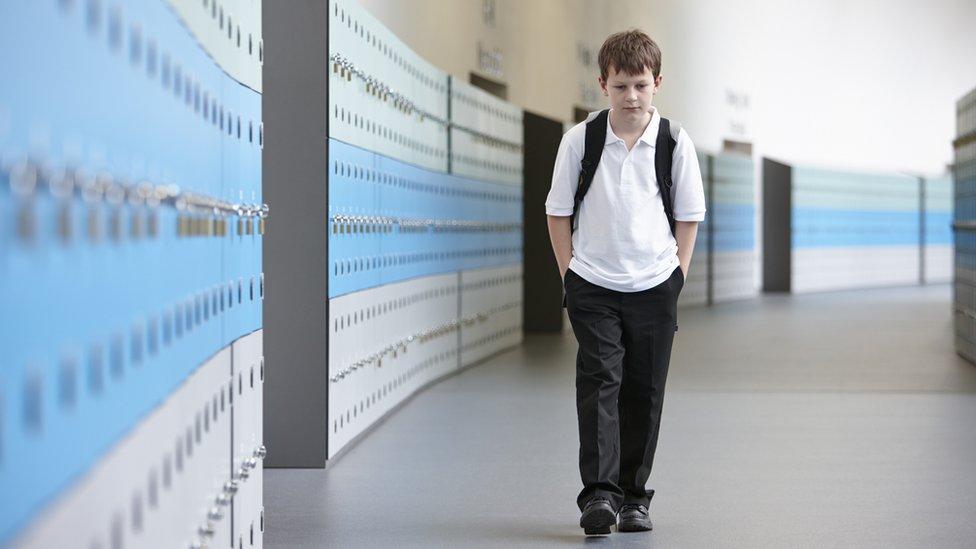Vote: How do you feel about school bubbles?
- Published
- comments

Secondary school can be a bit scary for some pupils
Starting secondary school marks the beginning of a brand new adventure for lots of students, but it can also be a bit scary.
Whether it's adjusting to a totally different school environment, meeting lots of new teachers, making new friends and getting used to all the lessons, there's often a lot to take in if you're a Year 7 student.
The coronavirus pandemic has also brought along some of its own unique challenges.
Many children who started secondary school last Autumn missed out on important experiences like taster days and school tours which provide prime opportunities for students to get to grips with their new schools before they enter Year 7.
The last year also saw the introduction of bubbles to help limit pupils' interactions with one another and tackle the spread of the virus.
New research, led by Dr Sandra Leaton Gray from University College London's Institute of Education, suggests bubbles have actually benefited lots of Year 7 students and they should be kept in place for longer to help the youngest students successfully transition into secondary school.
How do you feel about bubbles? Have your say in the vote below and let us know in the comments!
If you can't see this vote, try here.
What does the research say?
The report, called Moving Up, explores the different ways the coronavirus pandemic has affected the learning of pupils moving from primary school into secondary school.
The team which conducted the research asked lots of teachers and students to take part in an online survey and they also carried out interviews to find out how they'd been impacted by the pandemic.
The findings show the coronavirus pandemic and various lockdowns caused quite significant disruption to learning for lots of young students.
Some pupils didn't get a chance to physically visit their secondary schools before they started last September.
SATs were cancelled, the majority of learning moved to online platforms, school trips, sports days and end of school productions weren't able to go ahead and some children experienced more stress and anxiety.
What about bubbles?
Secondary school students have been put into bubbles to limit interaction with other pupils
Since pupils have returned to school, they've been put into bubbles, which require them to remain with the same group throughout the school day in order to keep everyone safe.
Secondary schools lessons often take place in different locations around a school, but many young students have ended up staying in the same classrooms with pupils from the same bubble for their different subjects.
Although this has been a negative for some students according to the report, many others have actually welcomed the bubbles.
"One of the things they find a bit scary is suddenly being in such a big building with so many people including lots of people who are much older than they are, " Dr Gray told Newsround.
Lots of secondary schools in England are very large, and they can often have well over 1000 pupils, the research explains. Smaller groups can help younger students feel a lot calmer and less overwhelmed.
Some students saw the bubbles as an opportunity to get used to their new school environment without the fear of being picked on by older students, getting lost in large buildings and becoming overwhelmed by all the new experiences that can come with starting secondary school.
I don't think we will move around for lessons or have our lockers...now that has been taken from me and I feel so sad and disappointed.
The report suggests that keeping Year 7 pupils separate from others for a longer period of time can help reduce stress levels.
"At the moment, schools are quite good at trying to help students move into secondary schools," said Dr Gray. "The preparation phase should last for the whole of year 7, they should get their own toilets, special area for break times and by Year 8, they should have adjusted better."
The findings also suggest that even if Year 7 students remain in smaller groups which remain separate from the rest of the school population, they should still be able to interact with other older pupils through things like clubs, trips and sports.
What did pupils say about bubbles?
It can be difficult for some children to adjust to secondary school
The students who took part in the study had lots of different thoughts about bubbles:
"We --- have to stay in the same classroom with our bubble otherwise it will get confusing and we will be touching the same seats the last class touched."
"The next school is going to be very big, so bit scared of getting lost because last time in the induction there or the open day I actually got lost … not so nice."
"Quite a lot of my friends are in the other bubble … it was in registration order and I am with just two of my friends."
"You can't do a lot of things like go in the science lab or art room, but for me because all your lessons are in one building it feels nicer."
- Published8 March 2021
- Published8 March 2021
- Published9 March 2021
